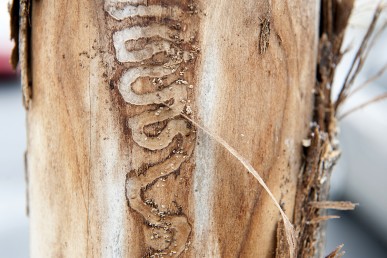Woodpeckers may be the answer to ash borer invasion

Biologists Christopher Whelan (left) and Charles Flower study the effectiveness of woodpeckers in stopping the emerald ash borer, which has killed 30 million trees in the northeastern U.S. and Canada. Photo: Roberta Dupuis-Devlin/UIC Photo Services
Since the emerald ash borer was first discovered in southeast Michigan in 2002, the Asian invader has been responsible for the death of 30 million trees in the northeastern U.S. and Canada.
The noxious pest has already attacked Chicago, where 17 percent of the street trees — about 85,000 — are ash, with an estimated 300,000 more ash trees on private property.
What can stop the onslaught of the voracious insect?
UIC researchers have an idea: woodpeckers.
“Woodpeckers may not be able to snuff them out, but they may be able to control them,” said Christopher Whelan, an avian ecologist with the Illinois Natural History Survey, UIC adjunct assistant professor of biology and coauthor of a recent report published online in the journal Forest Ecology and Management.
“We found we have a native predator that is able to detect and respond to this new rich food resource,” said Charles Flower, postdoctoral research associate in biology and first author of the study.
The researchers started their study in 2006, following the insects’ path across Ohio and Michigan “so that we could follow the decline of trees and the impact on the ecosystem,” Flower said.
Other exotic invasive species have run amok in new regions because there are no predators to keep them in check.
The researchers hoped the emerald ash borer might meet its match in native predators — bark foraging birds like the woodpecker and nuthatch.
This kind of “bio-control” is preferable to other methods of pest control, Flower said.
Chemical treatments are expensive and may harm trees and other fauna. Bringing an ash borer predator from its native range in Asia could create new problems, he said.
One way predators respond to a new abundant food source is called functional response. In this case, the woodpeckers alter their behavior to find emerald ash borers more efficiently, then consume them more than other prey.
In one woodland area monitored for the study, behind a middle school in Delaware, Ohio, schoolchildren did a precise accounting of bug and woodpecker activity.
When emerald ash borer larvae emerge from eggs laid on the tree, they burrow in and eat their way through the phloem layer of the tree, the vascular system that delivers water and nutrients from root to branch.
The insects create characteristic serpentine galleries that cut this vascular system, starving the tree. Eventually mature adults exit the tree to start the process again.
A section of trees behind the school was cut down each year for two years. The students searched for and painted all the holes they found in the bark of each tree — different colors for the woodpecker holes, the emerald ash borers holes and holes made by other insects.
The students tracked the fate of each bug that had been in the tree.
“This was looking at woodpecker foraging at a fine tree-by-tree scale,” said Flower.
Their results proved that woodpeckers were indeed preying on emerald ash borers — eating 85 percent of the emerald ash borer in an infested tree.
Another type of predator response to a new food source is a numerical response: the predators increase either because they were moving into the area or reproducing more successfully.
In a related study, researchers at Cornell tracked the movement of the emerald ash borer from Detroit and around the Great Lakes using a citizen scientist data base, the Project Feeder Watch. They determined that the number of three woodpecker species and the white-breasted nuthatch, the important bark foraging birds in this region, increased as the emerald ash borer increased.

Damage caused by the emerald ash borer on a tree outside SES. Photo: Roberta Dupuis-Devlin/UIC Photo Services
“But that study examined the bird population response and didn’t tell you what the birds were doing there,” Flower said.
“With the numerical response they found and the functional response we found, we have really powerful evidence of the potential of the woodpeckers and the nuthatch to have an impact on the population of the emerald ash borer,” Whelan said.
Very little is known about the emerald ash borer’s habits in its native environment or its natural predators, Flower said.
Slowing its course may give researchers time to learn more about how it can be controlled, he said.
“Woodpeckers won’t save a tree once it’s infested, but they may save the forest. Or at least save a nearby forest,” Flower said.
Other coauthors for the study were Lawrence Long, Ohio State University; Kathleen Knight and Joanne Rebbeck, U.S. Forest Service; and Joel Brown and Miquel Gonzalez-Meler, UIC.
